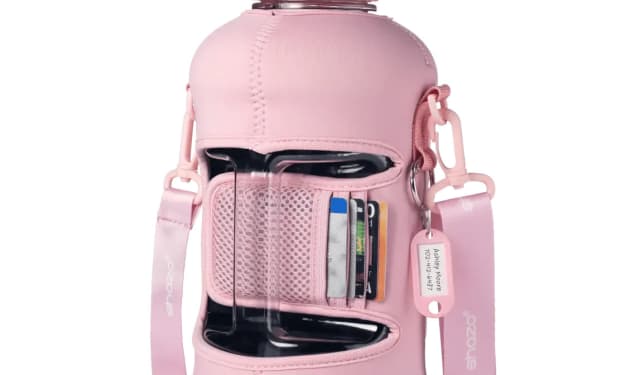Is Your Plastic Container Really Airtight? Here's How to Find Out!
Ensuring Food Freshness and Safety with Airtight Plastic Containers

Introduction
Airtight containers are a kitchen essential, but how can you be sure that your plastic container is truly airtight? Whether you're storing leftovers, meal-prepping for the week, or keeping dry goods fresh, understanding the airtightness of your containers can make a big difference. Products like the Shazo Airtight Food Storage Container sets are designed to help keep your food fresh for longer periods. Let's dive into the key factors and methods to determine if your plastic container is airtight.
The Importance of Airtight Containers
Maintaining Food Freshness
Ever pulled out some leftovers only to find them spoiled way too soon? Airtight containers help maintain the freshness and quality of your food by preventing air from seeping in and causing spoilage. This means your salads stay crisp, your pasta remains tasty, and your cookies don't turn into bricks.
Avoiding Contamination
No one wants to bite into a cookie and taste last night's garlic chicken. Airtight containers keep different food aromas and flavors from mingling, ensuring your food tastes as it should. Plus, they prevent unwanted pests and bacteria from getting into your food.
Key Features of Airtight Containers
Quality of Materials
Not all plastics are created equal. High-quality plastic is essential for ensuring that your container remains durable and truly airtight over time.
BPA-Free Options
When choosing a plastic container, always go for BPA-free options like those offered by Shazo. BPA is a chemical found in some plastics that can seep into food and beverages, posing health risks. BPA-free plastics are safer and often more durable.
Integrity of Seals
The seal is the heart of an airtight container. Without a good seal, your container is just a fancy bowl. Look for containers with strong, flexible seals.
Silicone and Gasket Seals
Many high-quality containers come with a gasket or silicone seal. These materials are flexible, ensuring a tight fit every time. They also withstand wear and tear better than plastic alone.
Locking Mechanisms
The way a lid locks onto the container is crucial. It needs to be secure and easy to use.
Snap-On Lids
Snap-on lids are common and can be effective if they fit tightly. However, they can sometimes wear out more quickly than other types.
Screw-On Lids
Screw-on lids offer a more secure seal, making them a great choice for long-term storage or liquid items. They are less likely to pop off if the container is dropped or knocked over.
Methods to Test Airtightness
Wondering if your container is truly airtight? Here are a few simple tests you can try at home.
Water Leakage Test
Fill your container with water, seal it, and give it a good shake. If any water leaks out, it's not airtight. Simple as that!
Air Pressure Test
Press down on the lid when it's sealed. If the lid springs back up or you hear air escaping, your container isn't airtight.
Submersion Test
Submerge the sealed container in a sink full of water. If bubbles escape, air is getting in, which means it's not airtight.
Factors That Impact Airtightness
Even the best containers can lose their airtightness over time due to several factors.
Temperature Changes
Extreme temperatures can cause plastic to warp and seals to weaken. Avoid exposing your containers to very hot or cold conditions whenever possible.
Wear and Tear
Regular use, washing, and the passage of time can all contribute to the breakdown of seals and the integrity of the plastic. Inspect your containers regularly for signs of wear.
Manufacturing Defects
Sometimes, the problem starts at the factory. A poorly made container may never be truly airtight. Check for uniformity in the seal and locking mechanism when you first buy it.
Selecting the Perfect Airtight Container
With so many options out there, picking the right container can be overwhelming. Here's what to consider.
Purpose of Use
Think about what you'll be using the container for. Dry goods, liquids, and leftovers all have different storage needs. Choose a container that matches your specific use case.
Size and Shape Considerations
The size and shape of your container can affect its airtightness. Ensure it's the right fit for your storage space and the types of food you plan to store. Smaller containers are generally more airtight than larger ones due to the decreased surface area.
Conclusion
Ensuring your plastic containers are airtight is crucial for maintaining food quality and safety. By understanding the characteristics of airtight containers and performing simple tests, you can confidently choose and use the best containers for your needs. Keep an eye on factors like temperature and wear, and don't hesitate to replace containers that are past their prime. Happy storing!
FAQs
How do I know if my container is airtight?
Perform tests like the water leakage test, air pressure test, or submersion test to check for airtightness.
What materials are best for airtight containers?
Look for BPA-free plastics with silicone or gasket seals for the best airtight performance.
Can I make my non-airtight container airtight?
You might improve the seal with a silicone wrap or a better-fitting lid, but it's best to invest in a high-quality airtight container.
How often should I replace my plastic containers?
Regularly inspect your containers for wear and tear. Replace them if you notice any cracks, warping, or seal degradation.
Are glass containers more airtight than plastic ones?
Glass containers with proper sealing lids can often be more airtight than plastic ones and are also more durable and eco-friendly.
About the Creator
Enjoyed the story? Support the Creator.
Subscribe for free to receive all their stories in your feed. You could also pledge your support or give them a one-off tip, letting them know you appreciate their work.





Comments
There are no comments for this story
Be the first to respond and start the conversation.